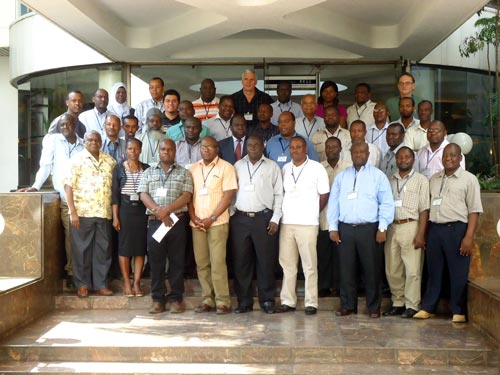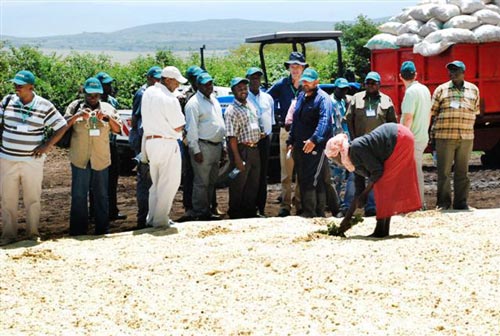NSIMA: Seeding hope for smallholder farmers through partnerships
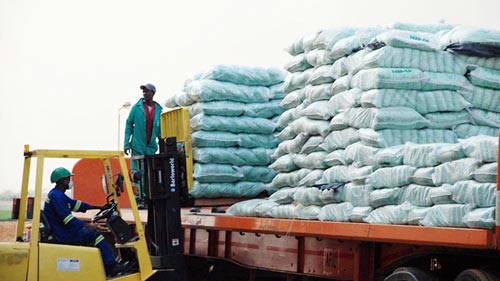 To achieve food security, smallholder farmers in Southern Africa require access to improved seed and inputs for higher yields. “Seed is one of the key movers in agricultural development,” says John MacRobert, New Seed Initiative for Maize in Southern Africa (NSIMA) leader, indicating the importance of going beyond developing improved seed varieties to encompass their dissemination, promotion, and adoption in developing strategies around seed development. These issues, together with NSIMA’s to date progress (the project is in its third phase) and strategies for the next phase, were discussed at a meeting in Lusaka, Zambia, during 7-9 August 2013. About 50 participants from institutions collaborating on the project led by CIMMYT and funded by the Swiss Agency for Development and Cooperation (SDC) were present; among them were representatives from national agricultural research institutes, seed companies, and institutions of higher learning from Angola, Botswana, Democratic Republic of the Congo, Lesotho, Malawi, Mozambique, Swaziland, South Africa, Zambia, and Zimbabwe.
To achieve food security, smallholder farmers in Southern Africa require access to improved seed and inputs for higher yields. “Seed is one of the key movers in agricultural development,” says John MacRobert, New Seed Initiative for Maize in Southern Africa (NSIMA) leader, indicating the importance of going beyond developing improved seed varieties to encompass their dissemination, promotion, and adoption in developing strategies around seed development. These issues, together with NSIMA’s to date progress (the project is in its third phase) and strategies for the next phase, were discussed at a meeting in Lusaka, Zambia, during 7-9 August 2013. About 50 participants from institutions collaborating on the project led by CIMMYT and funded by the Swiss Agency for Development and Cooperation (SDC) were present; among them were representatives from national agricultural research institutes, seed companies, and institutions of higher learning from Angola, Botswana, Democratic Republic of the Congo, Lesotho, Malawi, Mozambique, Swaziland, South Africa, Zambia, and Zimbabwe.
“Some of the challenges of the maize crop can be addressed by research,” said Moses Mwale, Zambia Agricultural Research Institute (ZARI) director, during the opening ceremony. “The rest can be addressed by other players in the maize sector,” he added, emphasizing the importance of collaboration within the maize seed value chain. Challenges such as variable distribution of rainfall, low soil fertility, and heat and drought stress can be addressed by improved varieties from CIMMYT-led projects including the Drought Tolerant Maize for Africa (DTMA) and Improved Maize for African Soils (IMAS). Other climate-change related issues in small-scale farming could be confronted via conservation agriculture. For example, cover crops and crop residue left on the soil help to retain moisture and thus mitigate the impact of droughts.
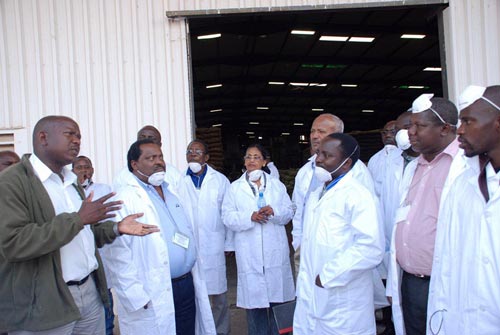 But do smallholder farmers have access to the new seeds, technologies, and information? The answer is often no. “Integrating stress tolerant maize and legumes, such as pigeon peas, beans, and cowpeas, leads to sustainable production systems. We need effective seed road maps to enhance access and availability of improved maize and legume seeds,” CIMMYT regional director for Southern Africa Mulugetta Mekuria said, giving an example of one such gap in the system.
But do smallholder farmers have access to the new seeds, technologies, and information? The answer is often no. “Integrating stress tolerant maize and legumes, such as pigeon peas, beans, and cowpeas, leads to sustainable production systems. We need effective seed road maps to enhance access and availability of improved maize and legume seeds,” CIMMYT regional director for Southern Africa Mulugetta Mekuria said, giving an example of one such gap in the system.
Seed companies and community-based organizations producing seed play a very significant role in fixing these issues. Nelson Munyaka from the SDC Seeds and Markets Project spoke of the success of Zaka Superseeds, a nascent seed company that transformed from a community seed enterprise. MacRobert agreed: “In Benin and Congo, where we do not have seed companies, the community seed producers could learn from Zaka’s experience and grow into full-fledged seed businesses with the proper structures.” DTMA project leader Tsedeke Abate added that mainstreaming drought tolerant maize varieties in the product portfolio of seed enterprises could have a significant impact.
Policy makers in the seed value chain must be engaged as well. “Many projects do not seem to believe in smallholder ability,” said consultant Michael Jenrich. The policies that govern the seed trade tend to vary among the Southern African Development Community (SADC) countries. An SDC-funded initiative to implement harmonized seed laws in all SADC countries to facilitate easier intra-regional seed movement is currently under way. “So far, 10 countries have signed the memorandum of understanding,” said K C Kawonga, SADC Seed Centre interim coordinator. Such laws would enhance seed trade and contribute to food security by ensuring farmers’ access to improved seed, especially during times of disaster.
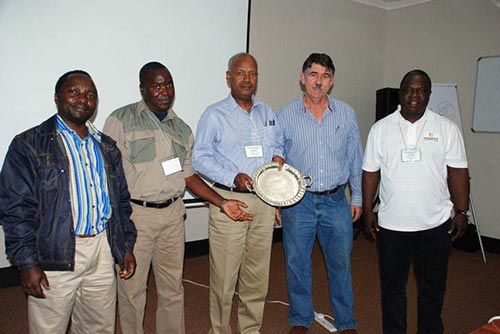 “Private sector players steer away from smallholders viewing them as high risk because of their poor infrastructure, lack of credit, and land tenure, while governments may not view them as a viable investment,” Jenrich summarized the lack of interest in smallholders’ problems. Zaka Superseeds proves them wrong; cooperating with smallholders can, in fact, be beneficial for seed companies, as they can work more closely with the community consuming their seed. Zaka, for example, is removing a product from its selection after consultations with the community during which they found out the discussed maize variety has a long maturity period and is thus undesirable.
“Private sector players steer away from smallholders viewing them as high risk because of their poor infrastructure, lack of credit, and land tenure, while governments may not view them as a viable investment,” Jenrich summarized the lack of interest in smallholders’ problems. Zaka Superseeds proves them wrong; cooperating with smallholders can, in fact, be beneficial for seed companies, as they can work more closely with the community consuming their seed. Zaka, for example, is removing a product from its selection after consultations with the community during which they found out the discussed maize variety has a long maturity period and is thus undesirable.
The meeting ended on a high note with the announcement of the 2012 DTMA Breeding and Dissemination Awards winners. Malawi won first prize for both categories; the breeding award runners-up were Zambia and Zimbabwe, and Zimbabwe also took second position in drought tolerant technologies dissemination.
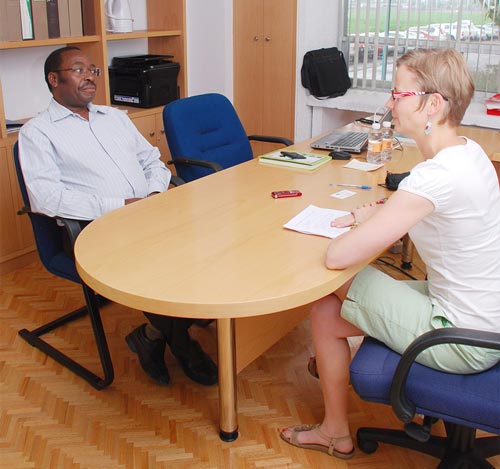 The Global Conservation Agriculture Program (GCAP) works closely with partners all over the world toward an ultimate vision of widespread use of sustainable systems by smallholder farmers, based on the principles of conservation agriculture (CA). Our key partner in Africa is the African Conservation Tillage Network (
The Global Conservation Agriculture Program (GCAP) works closely with partners all over the world toward an ultimate vision of widespread use of sustainable systems by smallholder farmers, based on the principles of conservation agriculture (CA). Our key partner in Africa is the African Conservation Tillage Network (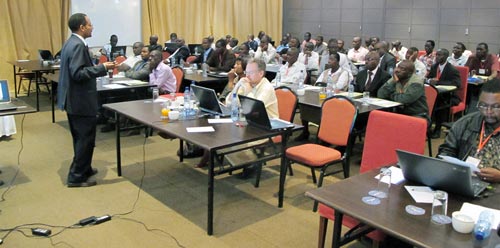 “Reducing post-harvest losses is key to increasing availability of food as it is not only important to increase domestic food production but also to protect what is produced by minimizing losses,” stated Zechariah Luhanga, Permanent Secretary, Provincial Administration at the Office of the President, Eastern Province, at the Provincial Stakeholders Workshop on Effective Grain Storage for Sustainable Livelihoods of African Farmers Project (EGSP-II) held in Chipata, Zambia, on 29 May 2013. “We as the key stakeholders and participants in the agricultural sector can enhance food security and improve incomes of resource poor farmers and artisans by promoting improved storage technologies such as metal silos and hermetic bags in Zambia.”
“Reducing post-harvest losses is key to increasing availability of food as it is not only important to increase domestic food production but also to protect what is produced by minimizing losses,” stated Zechariah Luhanga, Permanent Secretary, Provincial Administration at the Office of the President, Eastern Province, at the Provincial Stakeholders Workshop on Effective Grain Storage for Sustainable Livelihoods of African Farmers Project (EGSP-II) held in Chipata, Zambia, on 29 May 2013. “We as the key stakeholders and participants in the agricultural sector can enhance food security and improve incomes of resource poor farmers and artisans by promoting improved storage technologies such as metal silos and hermetic bags in Zambia.”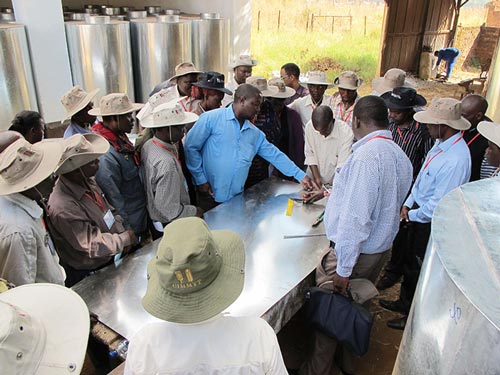 Agricultural extension service staff members in Zambia have been challenged to be the first adopters of metal silos to help promote the technology for effective grain storage. “I implore you, extension workers, to be the first adopters and users of the metal silo technology. As citizens that live side by side with farmers, go and be the first to practice what you will be preaching. You must lead by example,” stated Bert Mushala, the Permanent Secretary, Provincial Administration, Office of the President, Eastern Province, in a speech read on his behalf by his assistant Beenzu Chichuka at the official opening of the Improved Postharvest Management Training Workshop for Extension and Media Personnel held during 27- 28 May 2013 in Chipata, Zambia. “Farmers learn by seeing. Therefore, before they start using the metal silos, they want to see the chief executives, the business executives, extension workers, journalists, and other opinion leaders in the forefront, zealously storing maize in the metal silos,” he added.
Agricultural extension service staff members in Zambia have been challenged to be the first adopters of metal silos to help promote the technology for effective grain storage. “I implore you, extension workers, to be the first adopters and users of the metal silo technology. As citizens that live side by side with farmers, go and be the first to practice what you will be preaching. You must lead by example,” stated Bert Mushala, the Permanent Secretary, Provincial Administration, Office of the President, Eastern Province, in a speech read on his behalf by his assistant Beenzu Chichuka at the official opening of the Improved Postharvest Management Training Workshop for Extension and Media Personnel held during 27- 28 May 2013 in Chipata, Zambia. “Farmers learn by seeing. Therefore, before they start using the metal silos, they want to see the chief executives, the business executives, extension workers, journalists, and other opinion leaders in the forefront, zealously storing maize in the metal silos,” he added.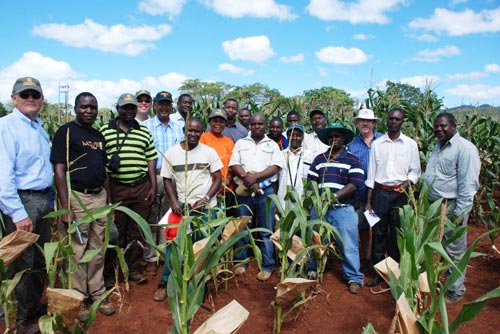 Covering 2,400 km, a multinational team toured Drought Tolerant Maize in Africa (
Covering 2,400 km, a multinational team toured Drought Tolerant Maize in Africa (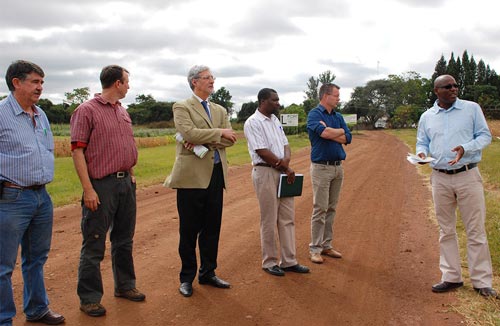
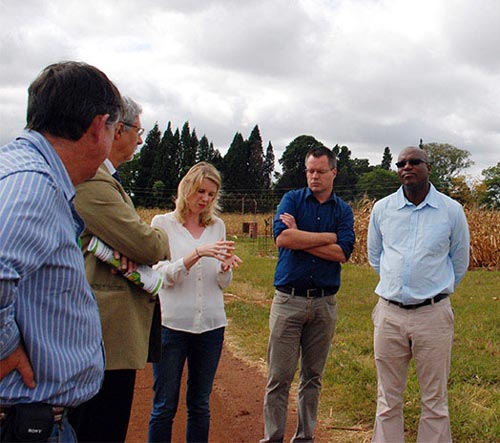
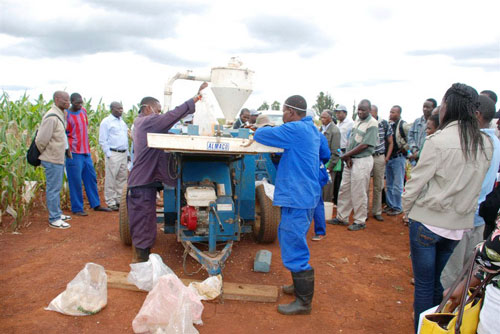 The field day was followed by a feedback session and a technical seminar on the maize lethal necrosis (MLN) disease that has emerged recently in East Africa. During the seminar presented by Magorokosho and MacRobert, principal director of the Department of Agriculture Research Services Danisile Hikwa expressed her appreciation to CIMMYT for its efforts to develop MLN resistant varieties.
The field day was followed by a feedback session and a technical seminar on the maize lethal necrosis (MLN) disease that has emerged recently in East Africa. During the seminar presented by Magorokosho and MacRobert, principal director of the Department of Agriculture Research Services Danisile Hikwa expressed her appreciation to CIMMYT for its efforts to develop MLN resistant varieties.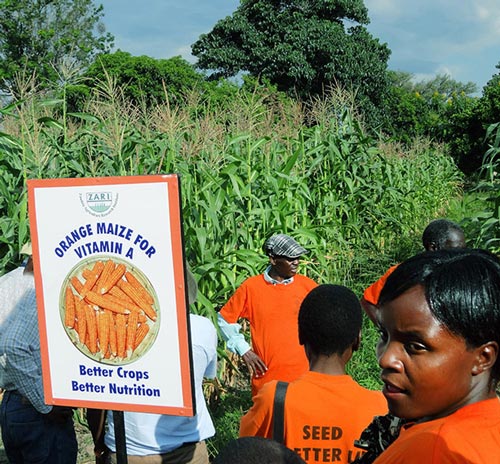 With over 50% of Zambian children under five vitamin A deficient, Zambia faces a major public health problem. This has resulted in several government intervention programs including vitamin A supplementation and sugar fortification, efforts which will soon be complemented by the release of three orange maize hybrids with higher levels of provitamin A carotenoids (compounds converted to vitamin A when consumed) developed by CIMMYT in collaboration with the Zambia Agriculture Research Institute (
With over 50% of Zambian children under five vitamin A deficient, Zambia faces a major public health problem. This has resulted in several government intervention programs including vitamin A supplementation and sugar fortification, efforts which will soon be complemented by the release of three orange maize hybrids with higher levels of provitamin A carotenoids (compounds converted to vitamin A when consumed) developed by CIMMYT in collaboration with the Zambia Agriculture Research Institute (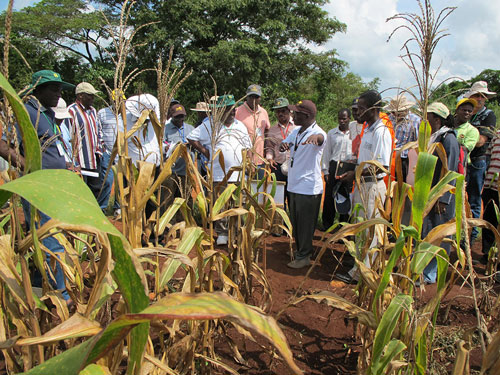 Over 200 researchers, policy makers, donors, seed companies, and NGO representatives from Africa and Australia gathered in Chimoio, Mozambique, during 17-23 March 2013 for the third
Over 200 researchers, policy makers, donors, seed companies, and NGO representatives from Africa and Australia gathered in Chimoio, Mozambique, during 17-23 March 2013 for the third 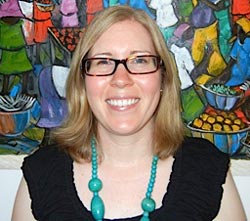 Nicole Mason is an assistant professor of International Development at the Department of Agricultural, Food, and Resource Economics at Michigan State University.
Nicole Mason is an assistant professor of International Development at the Department of Agricultural, Food, and Resource Economics at Michigan State University.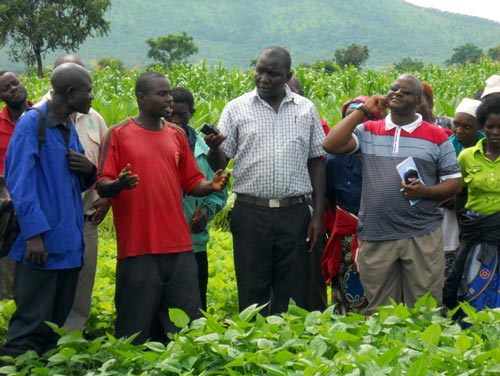 In rural areas surrounding Chipata in eastern Zambia, tobacco, cotton, and maize seem to dominate the agricultural landscape. If you look closer, you will also see smaller fields with groundnuts, cowpeas, soybeans, and sunflowers. But there is yet another dimension of diversity: the different growth stages and (inadequate) fertilization levels of the crops have resulted in a patchwork of yellow to deep green fields of many sizes and shapes, with various degrees of weed infestation. In this smallholder farming area with an average annual rainfall of more than 1,000 mm, it is neither easy to stay ahead of the weeds on all fields, nor to buy enough fertilizer for a healthy crop.
In rural areas surrounding Chipata in eastern Zambia, tobacco, cotton, and maize seem to dominate the agricultural landscape. If you look closer, you will also see smaller fields with groundnuts, cowpeas, soybeans, and sunflowers. But there is yet another dimension of diversity: the different growth stages and (inadequate) fertilization levels of the crops have resulted in a patchwork of yellow to deep green fields of many sizes and shapes, with various degrees of weed infestation. In this smallholder farming area with an average annual rainfall of more than 1,000 mm, it is neither easy to stay ahead of the weeds on all fields, nor to buy enough fertilizer for a healthy crop.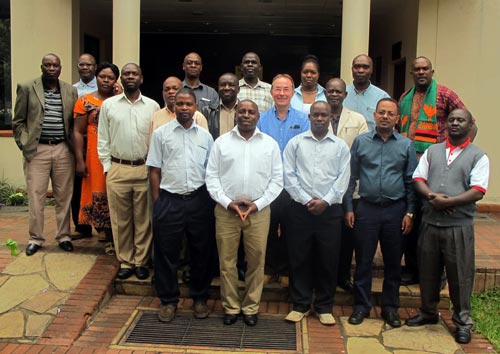
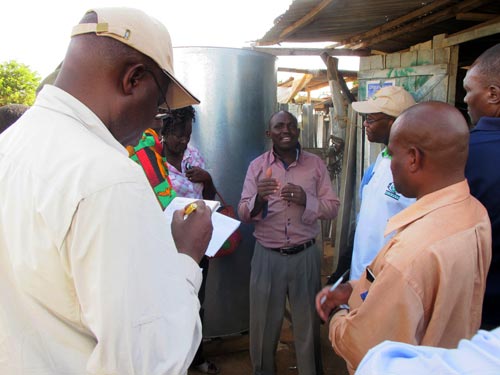 A delegation from Kenya, Malawi, Zimbabwe, and Zambia — the target countries of the Effective Grain Storage for Sustainable Livelihoods of African Farmers (EGSP) Phase-II Project— visited Malawi during 22-23 October and Kenya during 25-26 October 2012 to share experiences with project implementation and to learn about the project’s impact on the livelihoods of smallholder farmers. The delegation comprised of officials from ministries of agriculture and national agricultural research systems from the four EGSP countries, and implementing partners (Kenya Agricultural Research Institute and the Catholic Dioceses of Embu and Homa Bay in Kenya,
A delegation from Kenya, Malawi, Zimbabwe, and Zambia — the target countries of the Effective Grain Storage for Sustainable Livelihoods of African Farmers (EGSP) Phase-II Project— visited Malawi during 22-23 October and Kenya during 25-26 October 2012 to share experiences with project implementation and to learn about the project’s impact on the livelihoods of smallholder farmers. The delegation comprised of officials from ministries of agriculture and national agricultural research systems from the four EGSP countries, and implementing partners (Kenya Agricultural Research Institute and the Catholic Dioceses of Embu and Homa Bay in Kenya, 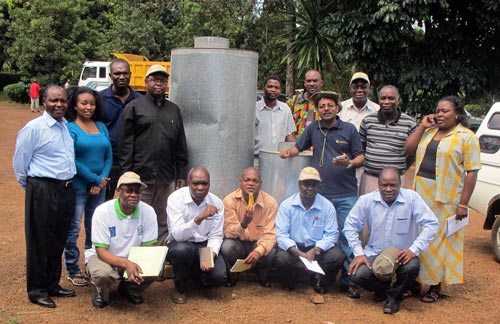
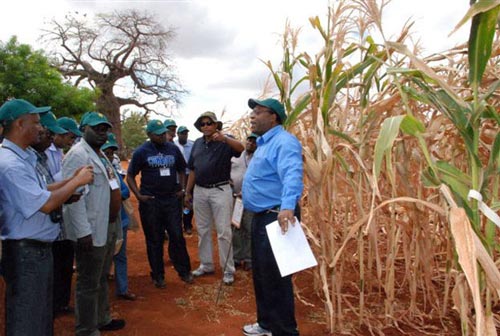 Thirty-six senior maize breeders from fifteen African countries participated in a course in Nairobi, Kenya, from 1 to 4 October 2012. The course attracted participants from national agricultural research systems, private seed companies, and universities collaborating within the Drought Tolerant Maize for Africa (
Thirty-six senior maize breeders from fifteen African countries participated in a course in Nairobi, Kenya, from 1 to 4 October 2012. The course attracted participants from national agricultural research systems, private seed companies, and universities collaborating within the Drought Tolerant Maize for Africa (